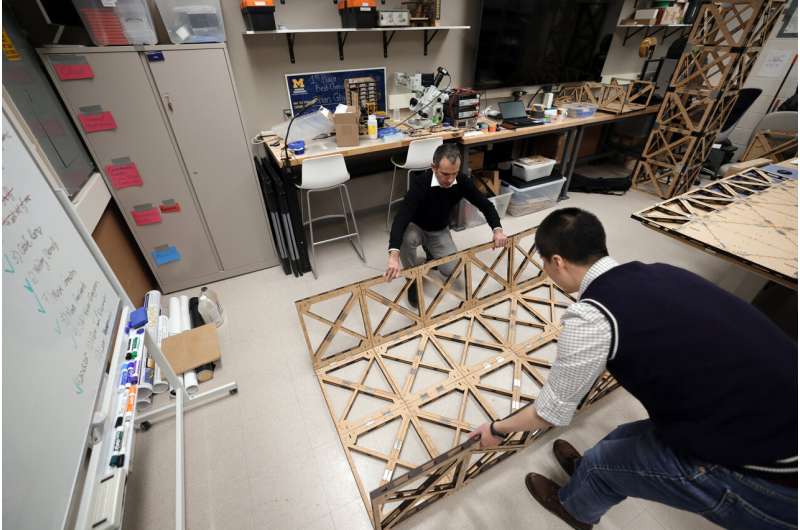This article has been reviewed according to Science X's editorial process and policies. Editors have highlighted the following attributes while ensuring the content's credibility:
fact-checked
trusted source
proofread
Bridge in a box: Unlocking origami's power to produce load-bearing structures

For the first time, load-bearing structures like bridges and shelters can be made with origami modules—versatile components that can fold compactly and adapt into different shapes—University of Michigan engineers have demonstrated.
It's an advance that could enable communities to quickly rebuild facilities and systems damaged or destroyed during natural disasters, or allow for construction in places that were previously considered impractical, including outer space. The technology could also be used for structures that need to be built and then disassembled quickly, such as concert venues and event stages.
"With both the adaptability and load-carrying capability, our system can build structures that can be used in modern construction," said Evgueni Filipov, an associate professor of civil and environmental engineering and of mechanical engineering, and a corresponding author of the study in Nature Communications.
Principles of the origami art form allow for larger materials to be folded and collapsed into small spaces. And with modular building systems gaining wider acceptance, the applications for components that can be stored and transported with ease have grown.
Researchers have struggled for years to create origami systems with the necessary weight capacities while keeping the ability to quickly deploy and reconfigure. U-M engineers have created an origami system that solves that problem. Examples of what the system can create include:
- A 3.3-foot-tall column that can support 2.1 tons of weight while itself weighing just over 16 pounds, and with a base footprint of less than 1 square foot.
- A package that can unfold from a 1.6-foot-wide cube to deploy into different structures, including: a 13-foot-long walking bridge, a 6.5-foot-tall bus stop and a 13-foot-tall column.
A key to the breakthrough came in the form of a different design approach provided by Yi Zhu, research fellow in mechanical engineering and first author of the study.
"When people work with origami concepts, they usually start with the idea of thin, paper-folded models—assuming your materials will be paper-thin," Zhu said. "However, in order to build common structures like bridges and bus stops using origami, we need mathematical tools that can directly consider thickness during the initial origami design."
To bolster weight-bearing capacity, many researchers have attempted to thicken their paper-thin designs in varying spots. U-M's team, however, found that uniformity is key.
"What happens is you add one level of thickness here, and a different level of thickness there, and it becomes mismatched," Filipov said. "So when the load is carried through these components, it starts to cause bending.
"That uniformity of the component's thickness is what's key and what's missing from many current origami systems. When you have that, together with appropriate locking devices, the weight placed upon a structure can be evenly transferred throughout."
In addition to carrying a large load, this system—known as the Modular and Uniformly Thick Origami-Inspired Structure system—can adapt its shapes to become bridges, walls, floors, columns and many other structures.
More information: Yi Zhu et al, Large-scale modular and uniformly thick origami-inspired adaptable and load-carrying structures, Nature Communications (2024). DOI: 10.1038/s41467-024-46667-0




















